
If your cat goes outdoors, there’s a chance that they could get bitten by a tick. You may have noticed them on your cat before. Tick bites are particularly common if they go through woodland areas or areas with long grass from spring to autumn time.
Because they can transmit several diseases, ticks can make our cats feel unwell, causing symptoms like lethargy, fever, discomfort, and pain. They can also spread diseases to humans, e.g. Lyme disease. It’s important to remove a tick as soon as you see it on your cat, as tick-borne diseases can spread from the tick within 24 hours. Removing a tick isn’t as straightforward as you might think, and there are a few tips to bear in mind before you do this.
Tick-borne diseases can spread to your cat within 24 hours of a tick bite, so it's important to remove the tick as soon as you can. You can use either a regular pair of tweezers or a special tick removal tool to extract the tick from your cat's skin. Cat owners can successfully remove a tick at home, but if you're uncomfortable, you can also bring your cat to a vet.Key Takeaways
Also Read: Flea And Tick Medication Poisoning In Cats: Causes, Symptoms, & Treatment
Identifying A Tick On Your Cat

Can you see the tick above this cat’s eye? Here’s how to identify ticks on your cat.
First of all, ensure that it definitely is a tick before you try to remove it. Ticks appear like small, round, well-attached lumps on your cat’s skin. There are over 900 species of ticks in the world, so they can vary a bit in color and size. In general, they’re small initially, and they grow larger the longer they’re attached to your cat. This is because they’re feeding on your cat’s blood!
Ticks can look very similar to a small lump or bump on your cat’s skin or even a nipple on the tummy area. It’s very important that we can identify ticks properly before we remove them to avoid causing harm to our cats. To identify a tick, the trick is to look for a few features that they have. The main thing to look for is tick legs. Adult ticks have eight legs, which you might be able to spot on either side of the lump. If you look closely, you might also notice a head on the tick which is how it attaches to the skin (through biting).
If you can’t see any head or legs and you’re not sure, it’s best to visit your veterinarian. If it’s not a tick and you try to remove it you might cause damage to the skin including bleeding and pain for your cat. It’s better to be safe if you’re unsure.
Also Read: Skin Lumps In Cats: Causes, Symptoms, & Treatment
How To Remove The Tick: Step By Step
Once you’ve confirmed that the lump is a tick, it’s important to remove it as soon as possible to prevent diseases transmitting. You can remove the tick yourself if you feel comfortable doing so. If not, visit your veterinarian and get them to do it.
If you’re removing the tick yourself at home we have a step-by-step guide that will ensure that you do this safely and efficiently.
Step 1: Put on Gloves
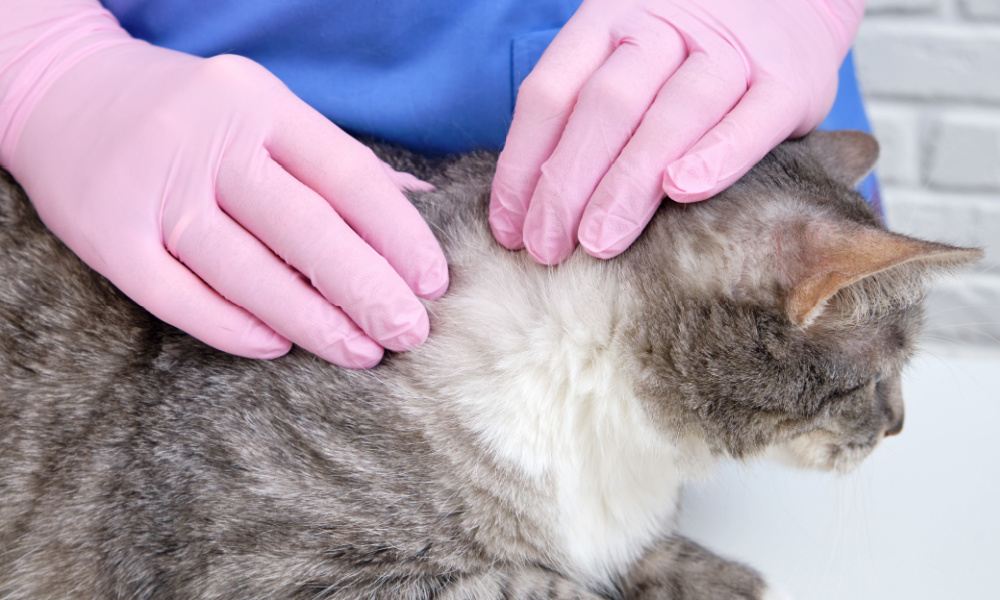
Before removing a tick from your cat’s body, put on gloves to ensure that you stay safe.
Wear gloves; firstly, before you start removing the tick put on a pair of disposable gloves. Ticks can spread to humans, so you need to be careful while removing them.
Step 2: Collect Your Tools
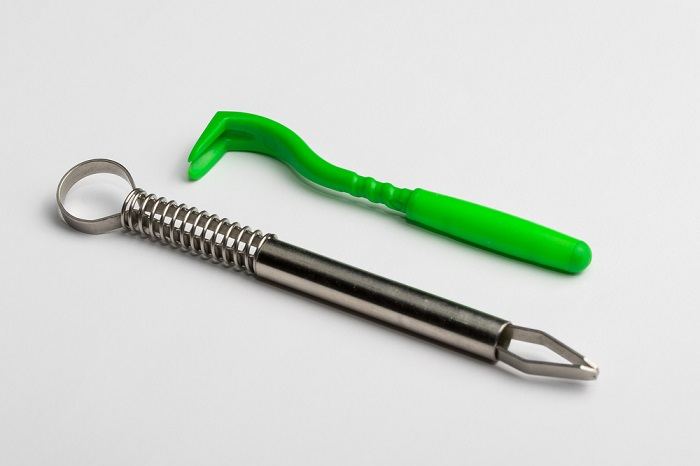
There are several tools available to help you extract ticks from your cat’s body. Regular tweezers will do, but you can also use specialized tick removal tools.
Get your equipment ready; you’ll need a pair of tweezers or tick removal tool, a bowl filled with some rubbing alcohol, antibiotic ointment or antiseptic if you have it, and someone to help hold your cat.
Step 3: Restrain Your Cat

Be sure to restrain your cat before starting to remove the tick.
Restrain your cat; get someone to gently restrain your cat so you can remove the tick safely. They can use treats to distract your cat and try to keep the experience as positive as possible.
Step 4: Carefully Remove the Tick
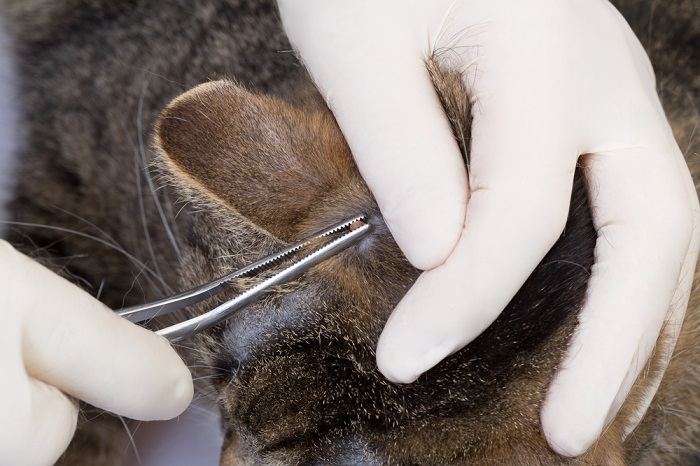
Using your tweezers or tick removal tool, carefully pull the tick from your cat’s skin.
Remove the tick; gently part the fur around the tick so you can visualize it. If using a tweezers, grasp the tick as close to your cat’s skin as possible and use gentle upward pressure to remove the entire tick. Try not to squeeze the body of the tick.
If using a tick removal tool, hook the tool underneath the tick and gently rotate/twist it in one direction with slight pressure until the tick is removed.
Step 5: Drop in Alcohol and Inspect
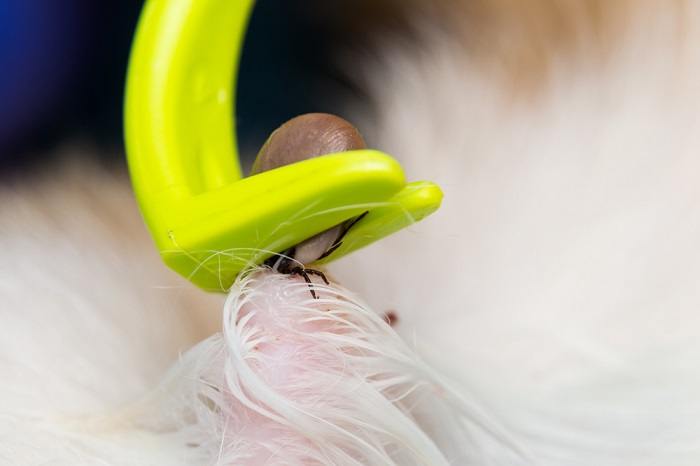
Once the tick has been removed, drop it in alcohol to kill it and inspect it to make sure that you extracted the bug’s entire body.
Check the tick and dispose of it; drop the tick into the bowl with alcohol to kill it. Check if you can see the legs and head of the tick, sometimes the tick’s head can get stuck in the skin. If this happens, contact your veterinarian for advice. Try to remove the whole tick if you can.
Step 6: Clean The Area
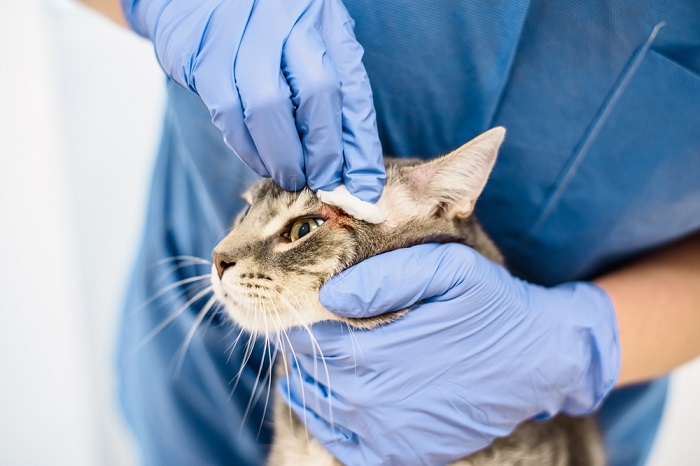
Gently clean the area after removing the tick. The skin may appear red and inflamed, but you should call the vet if you see extreme inflammation or discharge.
Clean the area; rub some antibiotic ointment or cat-safe antiseptic on the area where the tick was. The skin around the bite area might appear a little red and inflamed. Ring your vet if the area is very inflamed or discharging.
How To Prevent Ticks On Your Cat
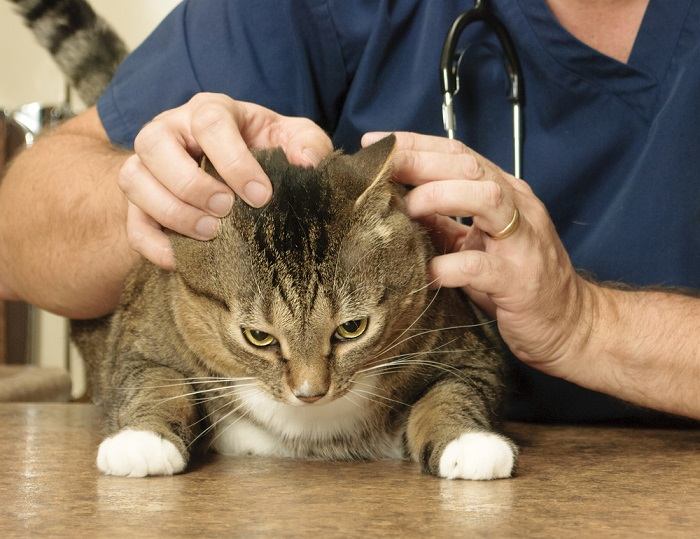
To prevent ticks on your cat, you should keep them indoors and consider a preventative product if they are exposed to ticks.
Ticks can cause irritation and localized pain at the site where they bite. Along with this, they can spread tick-borne diseases which can cause serious problems for both you and your cat. Diseases can spread quickly, some within 24 hours so it’s important to remove the tick as soon as you can. In kittens or vulnerable cats, large tick burdens can cause severe anemia and illness.
Check your cat regularly for ticks. It’s difficult to spot ticks in cats with long hair or dark-colored coats so it might take a while to check these cats. You can use treats or tasty cat food to get them used to being checked over.
The good news is that there are lots of tick preventatives out there on the market. These will prevent ticks from biting your cat and prevent infectious diseases from spreading.
Tick preventatives are usually in the form of a spot-on flea treatment that includes tick protection. Check with your local veterinary clinic about what tick preventatives they stock. Treatments usually cost between $10-40 depending on how long they last.
Also Read: Cat Fleas: Identification, Life Cycle, and Treatment
Conclusion

By staying calm and following a few simple steps, you can successfully remove ticks from your cat.
Ticks are dangerous parasites that can attach to your cat and transmit diseases. They often appear like a small lump on your cat’s skin and if you look closely you might notice a head and legs. You can remove the tick at home with our simple steps, but if you don’t feel comfortable doing that or if your cat is unwell, visit your veterinary clinic.
Also Read: Skin Cancer In Cats: Causes, Symptoms, & Treatment
Frequently Asked Questions
How do you remove a tick from a cat naturally?
The most natural way of removing a tick without using chemicals is to remove it with a tweezers or tick removal tool. It should be removed as soon as you notice it to prevent the transmission of disease to your cat.
Should I remove a tick from my cat?
Yes, if you feel comfortable, you should remove the tick. Read our simple steps on how to do this at home. If you don’t feel comfortable, get the tick removed at your veterinary clinic.
What happens if you leave a tick in a cat?
Ticks can cause localized inflammation and infection where they bite a cat, but they can also spread many tick-borne disease. Some of these diseases can spread to humans e.g. Lyme disease.
How does Vaseline remove ticks from cats?
Vaseline works by smothering the tick when applied. However, the time that it takes to kill the tick can vary, so I’d recommend physically removing the tick to prevent the transmission of disease, which can occur within 24 hours.







